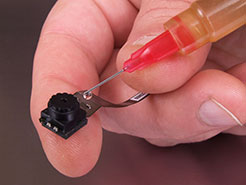
The properties of UV16 make it an excellent choice for many applications, including resonance extinction and biomedical products. The following are summaries of three use cases of UV16. Below is a table describing the applications and uses of UV16 summarized in this study.
Commercial and Research Uses of UV16
| Industry | Application | UV16 Uses | Critical Properties |
| Optical modulators | Microring resonators fabricated by electron beam bleaching of chromophore doped polymers1 | Provide high-integrity bond between substrate and solution | Cure properties Low viscosity for decreased bond thickness |
| Optical modulators | Polarity-independent optical waveguides2 | Provide high-integrity bond between substrate and solution | Low viscosity for decreased bond thickness |
| Instantaneous tissue scanning | Objective Lens for a Miniature Endoscopic Confocal Microscope3 | Enable fluorescent dye imaging and bond DOE to lens with create zero-gap seal | Low refractive index for dye imaging and low viscosity for minimal wicking and shrinkage |

Used in a wide range of applications, UV16 exhibits many properties that are advantaged for both performance and handling. Its viscosity is between 250-500 cps, greatly facilitating application where thin layers are desired. Its low shrinkage (1-2%) ensures the application surface area is primarily maintained after curing. UV16 exhibits a low refractive index of 1.511, which minimizes performance loss for electronic resonance reduction products. Since this is a one component system, there is no mixing involved, and it cures rapidly upon exposure to UV light at 365 nm. The polymer exhibits very high tensile strength/modulus and electrical insulation properties, mitigating weakening from exposure to extreme heat. Finally, UV16 is a cationic type cure system, which cures tack free and is not oxygen inhibited.
Sources
1Haishan, Sun, et al., "Microring resonators fabricated by electron beam bleaching of chromophore doped polymers." Applied Physics Letters 92, 193305, 2008.
2Sun, H. et al., "Polarization selective electro-optic polymer waveguide devices by direct electron beam writing." Optics Express vol. 16, no. 12, 8472-9, 2008.
3Ferradi, Nabil. "Objective lens for a miniature endoscopic confocal microscope." Montana State University, 2005
